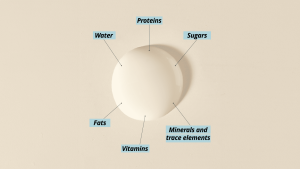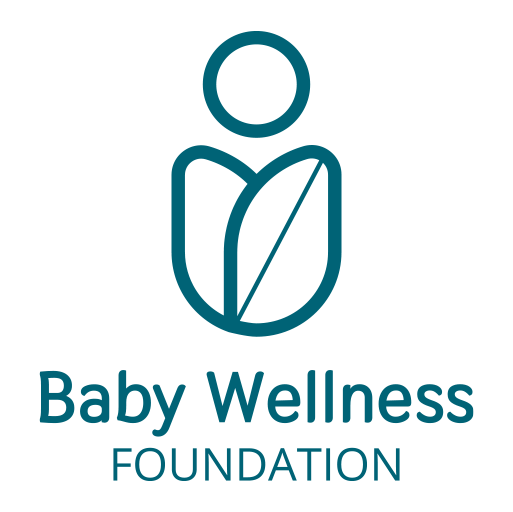Approfondimenti scientifici
Breast Milk: a complex system for neonatal nutrition
Breastfeeding is the expression of a complex and refined evolutionary process that integrates and harmonizes the neurobiological, microbiological, epigenetic, psychological, emotional-affective, and nutritional needs of the newborn. The importance of breast milk is undisputed and is rooted in two fundamental aspects: its composition and its ability to provide protection against infections.
From a compositional point of view, breast milk is a perfect and specific food for the newborn, as it contains exactly the nutrients needed for their development, both in quantity and quality. This composition is constantly evolving to adapt to the child’s changing needs over time, making breastfeeding a dynamic and personalized nutritional resource.
As for infection protection, breast milk works on two levels. First, thanks to the antibodies and other anti-infective agents it contains, it provides the infant with direct protection against pathogens and infections. Secondly, it promotes the development of a healthy and balanced gut microbiota, which is crucial for building a strong immune system. This helps reinforce the child’s natural defenses, reducing the risk of illness and promoting healthy growth.
The main components of breast milk
As the essential nourishment for infants, breast milk has a highly specialized composition optimized to meet the physiological and metabolic needs of the child. Its structure includes a wide range of nutrients essential for growth, development, and protection against infections, characterized by a delicate balance of water, proteins, lipids, carbohydrates, vitamins, and minerals.

Water and energy content
Breast milk is composed of about 87% water, ensuring adequate hydration for the infant. Water plays a critical role in detoxification processes, cell production, and maintaining fluid balance through urination and sweating. The average caloric content of breast milk is approximately 700 kcal per liter, which provides enough energy to support the metabolic demands and growth of the infant in the first months of life.
Proteins: supporting growth and development
Breast milk proteins are essential for proper tissue development in the newborn. Key proteins include casein, which supports bone and dental structure, and whey proteins, which aid in muscle development and immune function. Lactoferrin, a glycoprotein, is essential for iron transport, while immunoglobulin A (IgA) provides immune protection by forming a barrier on the intestinal mucosa, reducing permeability to pathogens and foreign antigens.
Sugars: energy and microbiota protection
Breast milk contains about 70 grams of carbohydrates per liter, primarily lactose. Lactose not only offers a quick energy source but also promotes the growth of lactobacilli, which acidify the gut and prevent pathogen proliferation. It also significantly enhances calcium absorption, essential for bone mineralization.
Fats: essential sources of energy and nutrients
Lipids in breast milk are mainly triglycerides, serving as a primary energy source. These include both saturated and unsaturated fatty acids, such as arachidonic acid (AA) and docosahexaenoic acid (DHA), which are crucial for nervous system development and visual maturation. AA and DHA are linked to improved cognitive and visual functions in infants. Additionally, fat-soluble vitamins A, D, E, and K are transported by these fats, aiding intestinal absorption and regulating metabolic processes.
Vitamins: supporting metabolism and the immune system
Breast milk offers a complete range of vitamins essential for the infant’s optimal growth and development. Vitamin D is crucial for calcium absorption and maintaining healthy bones and teeth. Vitamin K, found in high concentrations, plays a preventive role against neonatal hemorrhage. Vitamin C supports iron absorption and strengthens the immune system’s response to pathogens.
Minerals and trace elements: key to physical development
While breast milk contains a relatively small amount of minerals (around 2 grams per liter), it offers an optimal balance of calcium, phosphorus, and fluoride essential for skeletal and dental development. Iron in breast milk is highly bioavailable, with an absorption rate between 20% and 40%, far higher than that of cow’s milk or iron-fortified formulas.
Iron in breast milk is actively transported by lactoferrin, a glycoprotein crucial for iron uptake. Thanks to this mediated transport mechanism, the absorption efficiency reaches around 50%, compared to approximately 10% in cow’s milk and only about 4% in infant formulas. The high concentrations of vitamin C and lactose in breast milk further enhance iron absorption, improving the bioavailability of this essential mineral.
Vitamin C acts as a powerful reducing agent, converting ferric iron (Fe³⁺) into ferrous iron (Fe²⁺), a form more easily absorbed by the intestines. Meanwhile, lactose helps create an optimal intestinal environment for maximal micronutrient absorption, supporting proper hematopoiesis and the newborn’s physiological development. Other trace elements, such as zinc, copper, and manganese, are also more bioavailable than in formulas, contributing to a strengthened immune system and proper enzymatic function.
Akhtar, S., & Shaukat, S. (2021). Breastfeeding and Infant Health: The Protective Role of Breast Milk. Wiley-Blackwell.
Binns, C., Lee, M. K., & Low, W. Y. (2020). The Impact of Breastfeeding on Maternal and Child Health. Springer.
Gartner, L. M., Morton, J., Lawrence, R. A., et al. (2020). Breastfeeding and the Use of Human Milk. Pediatrics, 142(6).
Hanson, L. A. (2020). Breastfeeding and the Immune System. Springer.
Horta, B. L., & Victora, C. G. (2020). Long-term effects of breastfeeding: A systematic review. World Health Organization (WHO).
Kramer, M. S., & Kakuma, R. (2020). Optimal duration of exclusive breastfeeding. Cochrane Database of Systematic Reviews.
Labbok, M. H., & Mannel, R. (2020). Breastfeeding: A Guide for the Medical Profession (8th ed.). Elsevier.
Orfeo, L., Pippa, L., Bellini, C., et al. (2020). Breastfeeding and neurodevelopmental outcomes in preterm infants: A prospective study. Neonatology, 120(1).
Orfeo, L., Salvi, S., Mariani, G., et al. (2021). Breastfeeding and its impact on infant immunity. Pediatrics and Neonatology.
Rollins, N. C., Bhandari, N., Hajeebhoy, N., et al. (2020). Why invest, and what it will take to improve breastfeeding practices? The Lancet, 387(10017).
Semjonova, A. (2021). Ruolo dell’allattamento al seno sul microbiota intestinale nella prevenzione dell’obesità: una revisione della letteratura. LA CARE.
Victora, C. G., Bahl, R., Barros, A. J. D., et al. (2020). Breastfeeding in the 21st century: Epidemiology, mechanisms, and lifelong effect. The Lancet, 396(10248).
WHO (World Health Organization). (2020). Guideline: Protecting, Promoting and Supporting Breastfeeding in Facilities Providing Maternity and Newborn Services. World Health Organization.
